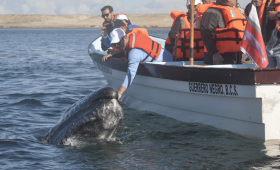There are very few moments in life that can stop you in your tracks—moments that seem to pause time itself. One of those moments, for those lucky enough to experience it, is making eye contact with a grey whale. It’s more than just a wildlife encounter; it’s a profound, deeply emotional experience that defies explanation and stays with you forever.
Imagine you're floating gently in a small boat in Laguna Ojo de Liebre, one of Baja California’s calm lagoons. The sun is warms your face, seabirds are call in the distance, and the water shimmers like liquid glass. Suddenly, a massive shadow moves beneath your boat. You hold your breath. A grey whale surfaces, mere feet away, and slowly lifts her head out of the water. And then—it happens. She looks right at you. Not in a vague, unseeing way, but with purpose. It’s as if she sees you. Really sees you.
A Connection Beyond Species
Making eye contact with a grey whale is unlike any other interaction between humans and wildlife. For a brief moment, the boundaries between species seem to blur. You're no longer just a spectator watching a magnificent creature from afar. You are a participant in an ancient and silent exchange—an exchange that is felt more than heard.
Many who have had the privilege of looking into a grey whale’s eye describe a sense of mutual recognition. There’s intelligence in that gaze. Curiosity. Calm. Sometimes even what feels like empathy. You might feel overwhelmed by the gentle enormity of the moment, or strangely comforted, like you’ve been let in on a secret the ocean has kept for millennia.
Grey whales have long memories. They return to the same breeding lagoons year after year. Some even approach boats voluntarily, seeking contact. This behavior is not only rare in the animal kingdom—it’s almost unheard of among large marine mammals. And yet, in Baja’s warm waters, grey whales seem to seek connection. The eye contact they offer isn’t a fluke. It feels intentional. It feels sacred.
The Eye of the Whale
A grey whale’s eye is small relative to its massive size—about the size of an orange—but it’s impossibly expressive. It shimmers with a depth that invites introspection. When you meet a whale’s gaze, you're seeing through an eye that has seen continents drift, oceans change, and generations pass.
The emotional response this encounter triggers in humans is often immediate and intense. Some people cry. Others laugh in disbelief. Many are struck silent. Scientists, tourists, photographers—no one is immune to the raw emotional gravity of that look. It’s a form of communication that bypasses language entirely, reaching straight into the soul.
Some marine biologists have even compared it to “meeting an ambassador from another world.” Not because whales are alien, but because they live in a realm so different from ours—silent, vast, and deep—yet they extend a moment of shared consciousness across the divide.
Why Baja?
These kinds of encounters aren’t random. They happen in specific places, most notably the lagoons of Baja California Sur, Mexico— Laguna Ojo de Liebre, San Ignacio Lagoon and Magdalena Bay. These protected areas serve as winter breeding and calving grounds for the Eastern North Pacific grey whale population. Every year, from late December to early April, thousands of grey whales migrate from the Arctic to these shallow, calm waters to give birth, nurse their young, and—remarkably—interact with humans.
Grey whales in Baja are known for their friendly behavior. They're often referred to as “the friendlies” for this very reason. They approach small boats, sometimes nudging them or even presenting their calves to visitors. But it’s the eye contact—the moment of soulful recognition—that defines the experience.
The Science of Empathy?
Can whales feel emotions like curiosity or compassion? Undoubtedly they can. Science is beginning to catch up with what many whale-watchers already feel intuitively. Cetaceans (whales, dolphins, and porpoises) have some of the most developed brains in the animal kingdom. They possess spindle cells—neurons linked to empathy and social behavior—similar to those found in humans and great apes.
While it’s difficult to ascribe human emotions to animals without concrete evidence, behavioral observations suggest that grey whales are highly intelligent, socially aware, and capable of individual choice. The decision to approach a boat, make eye contact, and linger in a calm, non-defensive state speaks volumes. These are not random acts of instinct—they are decisions. And that, in itself, is awe-inspiring.
An Emotional Tapestry: Stories from the Boats
Every eye contact tells a different story. For some, it’s a healing moment. Survivors of trauma or grief often describe the encounter as spiritually cleansing. For others, it’s a joyful confrontation with the raw beauty of nature. And for many, it sparks a deep reverence for marine life that turns into lifelong advocacy. Take, for example, the story of a cancer survivor who broke down in tears when a grey whale lingered at her side, looking up at her through the surface. Or the young child with autism who, normally withdrawn, laughed out loud when a whale blew a spout of misty air directly in front of him. These are not mere coincidences—they
are shared moments of presence, and they leave emotional imprints that last forever.
A Reminder of Our Place in the World
Making eye contact with a grey whale reminds us that we are not the sole protagonists of Earth’s story. We are part of a much larger narrative—one that includes creatures that think, feel, and communicate in ways we are only beginning to understand.
In our fast-paced, hyperconnected world, it's easy to lose touch with the natural world. But one moment of eye contact with a grey whale can jolt you back into awareness. It’s grounding. It’s humbling. It strips away ego and reminds you of the beauty and mystery that still exists just beneath the surface.
Conservation Through Connection
Experiences like these have power beyond the emotional. They fuel conservation efforts. When people connect emotionally with wildlife, they become invested in protecting it. The grey whales’ friendly behavior has sparked countless documentaries, research grants, eco-tourism programs, and grassroots conservation movements.
Baja’s responsible whale-watching guidelines ensure that these experiences are safe for both whales and humans. Boats maintain respectful distances, limit the number of visitors, and follow strict time limits. And still, the whales come. That’s perhaps the most astonishing part: these wild animals choose to connect with us.
Preparing for the Encounter
If you’re planning to visit Baja for a grey whale experience, prepare for more than just a tour. Prepare for an emotional journey. Dress warmly, bring binoculars, and pack your camera—but also come with an open heart. Be patient. Sometimes the whales approach; sometimes they don’t. And that’s okay. The ocean is not a zoo—it’s a living, breathing entity that offers gifts on its own terms.
But if and when a whale rises beside your boat and looks you in the eye, be ready to meet the moment fully. Put your camera down for a second. Look back. Feel the silence. Let the connection happen. It may last only a few seconds, but it will change you forever.
Final Thoughts: A Sacred Glimpse
Making eye contact with a grey whale isn’t just a highlight of a vacation—it’s a spiritual experience. It’s a moment that reconnects you with nature, with humility, and with a sense of wonder that often gets lost in daily life.
In that gaze, you don’t just see a whale. You see a survivor of whaling, a mother nurturing her calf, a fellow being who has crossed oceans and time. You see the story of our planet—fragile, beautiful, and interconnected.
Consider a short 4 to 6 day vacation on the shore of Laguna Ojo de Liebre. Where laying in bed at night in one of the Baja Jones whale camp cabins you can hear these gentle giants breathing. Then in the morning walk to the dock and let the boat glide you to another emotional fun day.
And in that moment, everything will make sense.



